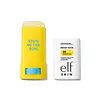What's inside
What's inside
 Key Ingredients
Key Ingredients

 Benefits
Benefits

 Concerns
Concerns

 Ingredients Side-by-side
Ingredients Side-by-side

Octocrylene 10%
UV AbsorberHomosalate 7.3%
Skin ConditioningEthylhexyl Salicylate 5%
UV AbsorberButyl Methoxydibenzoylmethane 3%
UV AbsorberDiphenylsiloxy Phenyl Trimethicone
Skin ConditioningParaffinum Liquidum
EmollientHydroxystearic Acid
CleansingTriethylhexanoin
MaskingDibutyl Lauroyl Glutamide
Skin ConditioningSilica
AbrasiveC12-15 Alkyl Benzoate
AntimicrobialHelianthus Annuus Seed Oil
EmollientPolyamide-8
EmollientSilica Silylate
EmollientOryzanol
Skin ConditioningEthylhexylglycerin
Skin ConditioningBisabolol
MaskingTriethoxycaprylylsilane
Tocopherol
AntioxidantWater
Skin ConditioningButylene Glycol
HumectantPhenoxyethanol
PreservativeCitrullus Lanatus Fruit Extract
Skin ConditioningOctocrylene 10%, Homosalate 7.3%, Ethylhexyl Salicylate 5%, Butyl Methoxydibenzoylmethane 3%, Diphenylsiloxy Phenyl Trimethicone, Paraffinum Liquidum, Hydroxystearic Acid, Triethylhexanoin, Dibutyl Lauroyl Glutamide, Silica, C12-15 Alkyl Benzoate, Helianthus Annuus Seed Oil, Polyamide-8, Silica Silylate, Oryzanol, Ethylhexylglycerin, Bisabolol, Triethoxycaprylylsilane, Tocopherol, Water, Butylene Glycol, Phenoxyethanol, Citrullus Lanatus Fruit Extract
Zinc Oxide 10%
Cosmetic ColorantTitanium Dioxide 5.5%
Cosmetic ColorantWater
Skin ConditioningCyclopentasiloxane
EmollientC12-15 Alkyl Benzoate
AntimicrobialCaprylyl Methicone
Skin ConditioningIron Oxides
Glycerin
HumectantLauryl PEG-9 Polydimethylsiloxyethyl Dimethicone
Skin ConditioningOctyldodecyl Neopentanoate
EmollientDimethicone
EmollientAlumina
AbrasiveSodium Chloride
MaskingSodium Hyaluronate
HumectantTocopherol
AntioxidantAscorbyl Palmitate
AntioxidantEthylhexylglycerin
Skin ConditioningMethicone
EmollientTriethoxysilylethyl Polydimethylsiloxyethyl Hexyl Dimethicone
Skin ConditioningPolyglyceryl-3 Polydimethylsiloxyethyl Dimethicone
Skin ConditioningDimethicone/PEG-10/15 Crosspolymer
Disteardimonium Hectorite
StabilisingPropylene Carbonate
SolventPolyhydroxystearic Acid
EmulsifyingTriethoxycaprylylsilane
Phenoxyethanol
PreservativeZinc Oxide 10%, Titanium Dioxide 5.5%, Water, Cyclopentasiloxane, C12-15 Alkyl Benzoate, Caprylyl Methicone, Iron Oxides, Glycerin, Lauryl PEG-9 Polydimethylsiloxyethyl Dimethicone, Octyldodecyl Neopentanoate, Dimethicone, Alumina, Sodium Chloride, Sodium Hyaluronate, Tocopherol, Ascorbyl Palmitate, Ethylhexylglycerin, Methicone, Triethoxysilylethyl Polydimethylsiloxyethyl Hexyl Dimethicone, Polyglyceryl-3 Polydimethylsiloxyethyl Dimethicone, Dimethicone/PEG-10/15 Crosspolymer, Disteardimonium Hectorite, Propylene Carbonate, Polyhydroxystearic Acid, Triethoxycaprylylsilane, Phenoxyethanol
 Reviews
Reviews

Ingredients Explained
These ingredients are found in both products.
Ingredients higher up in an ingredient list are typically present in a larger amount.
C12-15 Alkyl Benzoate is made up of Benzoic Acid and long chain alcohols. It has a low molecular weight.
C12-15 Alkyl Benzoate is an emollient and texture enhancer. Due to its solubility, it is often used in sunscreens to help evenly distribute active ingredients.
As an emollient, C12-15 Alkyl Benzoate helps soften and hydrate your skin. Emollients create a film on your skin that traps moisture within.
This ingredient has been reported to cause eye irritation.
Learn more about C12-15 Alkyl BenzoateEthylhexylglycerin (we can't pronounce this either) is commonly used as a preservative and skin softener. It is derived from glyceryl.
You might see Ethylhexylglycerin often paired with other preservatives such as phenoxyethanol. Ethylhexylglycerin has been found to increase the effectiveness of these other preservatives.
Phenoxyethanol is a preservative that has germicide, antimicrobial, and aromatic properties. Studies show that phenoxyethanol can prevent microbial growth. By itself, it has a scent that is similar to that of a rose.
It's often used in formulations along with Caprylyl Glycol to preserve the shelf life of products.
Tocopherol (also known as Vitamin E) is a common antioxidant used to help protect the skin from free-radicals and strengthen the skin barrier. It's also fat soluble - this means our skin is great at absorbing it.
Vitamin E also helps keep your natural skin lipids healthy. Your lipid skin barrier naturally consists of lipids, ceramides, and fatty acids. Vitamin E offers extra protection for your skin’s lipid barrier, keeping your skin healthy and nourished.
Another benefit is a bit of UV protection. Vitamin E helps reduce the damage caused by UVB rays. (It should not replace your sunscreen). Combining it with Vitamin C can decrease sunburned cells and hyperpigmentation after UV exposure.
You might have noticed Vitamin E + C often paired together. This is because it is great at stabilizing Vitamin C. Using the two together helps increase the effectiveness of both ingredients.
There are often claims that Vitamin E can reduce/prevent scarring, but these claims haven't been confirmed by scientific research.
Learn more about TocopherolTriethoxycaprylylsilane is a silicone used to bind and stabilize ingredients.
As an emulsifier, it helps prevent ingredients from separating. This can help elongate the shelf life of products.
Triethoxycaprylylsilane is often used to coat mineral sunscreens ingredients to help give a better feel. It also helps reduce oxidative stress in sunscreens.
Learn more about TriethoxycaprylylsilaneWater. It's the most common cosmetic ingredient of all. You'll usually see it at the top of ingredient lists, meaning that it makes up the largest part of the product.
So why is it so popular? Water most often acts as a solvent - this means that it helps dissolve other ingredients into the formulation.
You'll also recognize water as that liquid we all need to stay alive. If you see this, drink a glass of water. Stay hydrated!
Learn more about Water